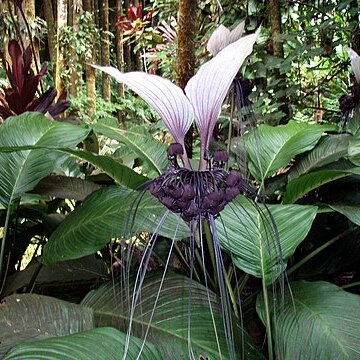Terrestrial, erect, perennial, mostly rosulate, scapose herbs. Rhizome tuberous, solid, starchy, globose or elongate, either with apical growth or with spaced growing points. Leaves up to 13, appearing together with the inflorescence, either spaced or crowded on the rhizome, petioled, entire, pinnatifid, palmatipartite or palmatisect and palmatisect with pinnately divided segments; herbaceous to chartaceous; nervation palmate or pinnate; venation reticulate; petioles erect, ribbed, canaliculate distally, glabrous, with a sheathing base, solid, rarely hollow. Inflorescences umbellate, involucrate, sometimes bracteate; peduncle(s) (scape) simple, solid, very rarely hollow, erect, ribbed, distally canaliculate. Involucral bracts mostly 4 in 2 whorls (in T. leontopetaloides 4-12, in T. bibracteata 2), herbaceous, mostly erect, the outer ones mostly longer persisting after anthesis than the inner ones which are likewise originating later in the young stage of growing, always flattened, entire, parallel-or curvinerved, sometimes also pinnately nerved. Floral bracts, if present, filiform, never flattened, of the same number as the flowers, caducous after anthesis. Flowers actinomorphic, bisexual, epigynous, gamophyllous, with 6 lobes in 2 whorls, imbricate in bud, mostly very dark coloured, parallel-or curvinerved; pedicels 6-ribbed, elongated and thickened in fruit. Stamens 6, inserted on the corolla tube, epitepalous, outer ones slightly larger than inner ones; filaments short and flattened, at the base — except for the margins, which are inflexed — adnate to the perianth tube, this portion rhomboid in outline; the free portion helmet-shaped; thecae placed at the inner side of the helmet, introrse, lengthwise dehiscent. Ovary 1-celled, 3-carpellate, obpyramidal, 6-ribbed; placentas 3, parietal, each with ∞ pendulous, apotropous-anatropous ovules; disk sometimes present; style 1, provided with 3 — sometimes deeply — incised wings, its apex with 3 obcordate lobes, each provided with a clear stigmatic canal. Fruits berry-like, with a fleshy pericarp, 6-ribbed, irregularly desintegrating, rarely (in one extra-Mal. sp.) dehiscent. Seeds completely filling the fruit, l0-∞. with a strongly ribbed, mostly glabrous testa and a mostly distinct raphe.
More
Glabrous or sparsely pilose herbs. Tuber subglobose. Bracts green or coloured, the 2 outer sessile, the inner sessile or scarcely petiolate ; filiform bracts usually present. Perianth-segments subequal, reflexed, spreading, or erect. Stigma-lobes emarginate. Fruit baccate. Seeds reniform or ovate ; embryo minute, buried in the endosperm.
Mostly on the floor of moist evergreen primary and secondary forests, but T. palmata also under seasonal climatic conditions for example in teak forest, and possibly T. chantrieri also in seasonal or dry evergreen forest in SE. Asia, not bound to special soil types. T. leontopetaloides has a far wider distribution and deviates from the other species in rarely occurring in primary forest but preferring secondary forest and thickets, and many open situations, clearings, grassland, savannah, coconut groves, and beach vegetation (Barringtonia formation), not shunning seasonally dry areas, such as teak and eucalypt woodland; its originally native habitat is probably the beach forest, but because of the food value of its tubers it is likely that it has been dispersed by man since time immemorial and though this can no longer be traced and proved it is likely that a great part of its range has been effected by man.As to altitude, most species are restricted to the lowlands ascending to c. 1000 m; T. palmata, however, has been found up to 1200(-1500) m.

